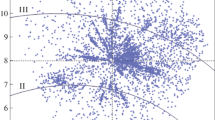Abstract
The fundamental properties of 24 Galactic WN stars are determined from analyses of their optical, UV and IR spectra using sophisticated model atmosphere codes (Hillier, 1987, 1990). Terminal velocities, stellar luminosities, temperatures, mass loss rates and abundances of hydrogen, helium, carbon, nitrogen and oxygen are determined. Stellar parameters are derived using diagnostic lines and interstellar reddenings found from fitting theoretical continua to observed energy distributions.
Our results confirm that the parameters of WN stars span a large range in temperature (T*=30–90,000 K), luminosity (log L*/L⊙=4.8–5.9), mass loss (M=0.9–12×10−5 M⊙ yr−1) and terminal velocity (v ∞=630–3300 km s−1). Hydrogen abundances are determined, and found to be low in WNEw and WNEs stars (<15% by mass) and considerable in most WNL stars (1–50%). Metal abundances are also determined with the nitrogen content found to lie in the range N/He=1–5×10−3 (by number) for all subtypes, and C/N ∼0.02 in broad agreement with the predictions of Maeder (1991). Enhanced O/N and O/C is found for HD 104994 (WN3p) suggesting a peculiar evolutionary history. Our results suggest that single WNL+abs stars may represent an evolutionary stage immediately after the Of phase. Since some WNE stars exist with non-negligible hydrogen contents (e.g. WR136) evolution may proceed directly from WNL+abs to WNE in some cases, circumventing the luminous blue variable (LBV) or red supergiant (RSG) stage.
Similar content being viewed by others
References
Bohannan, B., Voels, S.A., Hummer, D.G. & Abbott, D.C., 1990.Astrophys. J.,365, 729.
Crowther, P.A. PhD thesis, University of London, 1993.
Garmany, C.D. & Conti, P.S., 1984.Astrophys. J.,284, 705.
Hamann, W-R., Wessolowski, U. & Koesterke, L., 1993.Astr. Astrophys. submitted.
Hillier, D.J., 1987.Astrophys. J. Suppl.,63, 947.
Hillier, D.J., 1988.Astrophys. J.,327, 822.
Hillier, D.J., 1990.Astr. Astrophys.,231, 116.
Hillier, D.J., 1991.Astr. Astrophys.,247, 455.
Howarth, I.D. & Schmutz, W., 1992.Astr. Astrophys.,261, 503.
Koesterke, L., Hamann, W-R., Schmutz, W. & Wessolowski, U., 1991.Astr. Astrophys.,248, 166.
Maeder, A., 1991. In:Evolution of Stars: The Photospheric Abundance Connection IAU Symposium 145, eds. Michaud, G. & Tutukov, A., p. 221, Kluwer, Dordrecht.
Moffat, A.F.J., 1989.Astrophys. J.,347, 373.
Schaller, G., Schaerer, D., Meynet, G. & Maeder, A., 1992.Astr. Astrophys. Suppl.,96, 269.
Schmutz, W., Hamann, W-R. & Wessolowski, U., 1989.Astr. Astrophys.,210, 236.
Smith, L.F. & Maeder, A., 1989.Astr. Astrophys.,211, 71.
St-Louis, N. PhD thesis, University of London, 1990.
van Genderen, A.M. & et al., 1991. In:Wolf-Rayet Stars and Interrelations with other Massive Stars in Galaxies, IAU Symposium 143, eds. van der Hucht, K.A. & Hidayat, B., p. 129, Kluwer, Dordrecht.
Author information
Authors and Affiliations
Rights and permissions
About this article
Cite this article
Crowther, P.A., Smith, L.J. & Hillier, D.J. Tailored analyses of 24 Galactic WN stars. Space Sci Rev 66, 271–275 (1993). https://doi.org/10.1007/BF00771076
Issue Date:
DOI: https://doi.org/10.1007/BF00771076



